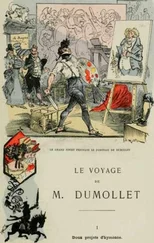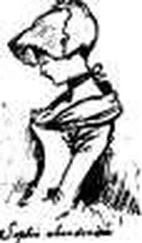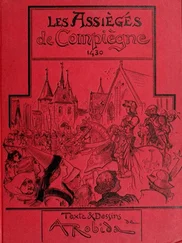Albert Robida - Yester-year; ten centuries of toilette from the French of A. Robida
Здесь есть возможность читать онлайн «Albert Robida - Yester-year; ten centuries of toilette from the French of A. Robida» весь текст электронной книги совершенно бесплатно (целиком полную версию без сокращений). В некоторых случаях можно слушать аудио, скачать через торрент в формате fb2 и присутствует краткое содержание. Жанр: Старинная литература, на английском языке. Описание произведения, (предисловие) а так же отзывы посетителей доступны на портале библиотеки ЛибКат.
- Название:Yester-year; ten centuries of toilette from the French of A. Robida
- Автор:
- Жанр:
- Год:неизвестен
- ISBN:нет данных
- Рейтинг книги:4 / 5. Голосов: 1
-
Избранное:Добавить в избранное
- Отзывы:
-
Ваша оценка:
- 80
- 1
- 2
- 3
- 4
- 5
Yester-year; ten centuries of toilette from the French of A. Robida: краткое содержание, описание и аннотация
Предлагаем к чтению аннотацию, описание, краткое содержание или предисловие (зависит от того, что написал сам автор книги «Yester-year; ten centuries of toilette from the French of A. Robida»). Если вы не нашли необходимую информацию о книге — напишите в комментариях, мы постараемся отыскать её.
Yester-year; ten centuries of toilette from the French of A. Robida — читать онлайн бесплатно полную книгу (весь текст) целиком
Ниже представлен текст книги, разбитый по страницам. Система сохранения места последней прочитанной страницы, позволяет с удобством читать онлайн бесплатно книгу «Yester-year; ten centuries of toilette from the French of A. Robida», без необходимости каждый раз заново искать на чём Вы остановились. Поставьте закладку, и сможете в любой момент перейти на страницу, на которой закончили чтение.
Интервал:
Закладка:
The Hennin \\ith largo veil.
women simply let them talk, and imperturbably followed the fashions.
In matters of the Mode, women were then, as they are now, a law unto themselves, they ignored all authority, royal, ecclesiastical, or marital.
The ladies of the period wore shoes 'à poiilaine ' ; those famous slioes with their turned-up points were adopted by the other sex, and adorned with a little ringing bell at the curved end.
High lieels were as yet unknown, but they gradually grew out of a kind of slipper with several soles placed one above the other. Headdresses assumed extravagant proportions, and the ' Hennin ' triumphed over all its rivals. The *Escofïîon' took various forms, now that of a crescent, anon that of a turban ; then there was the heart-shaped cap, a pompous head-tire of embi'oidered stuff, trellised with braid, adorned with beads, and having a wide frontlet set wàth jewels, which came down to the forehead in the form of a heart. It was, however, the great horned ' escoffion ' that gave offence in particular to the preachers; this curious structure consisted of a broad cylinder of rich stuff ornamented with jewels, terminating in two horns.
with a streamer of fine muslin which fell upon the shoulders from each point.
These ' escoffions '—(the term is obsolete, and has no equivalent in English)—were said to come from England, like many other eccentricities of costume at all times. The Anglomania that breaks out now and again, dates from afar. VioUet-le-Duc gives an example in his Dictionnaire du MoMlicr of a 'grand escof-fion ' on the statue of a Countess of Arundel who lived at the beginning of the fifteenth century. Preachers and moralists, comparing the women who wore those head-dresses to horned beasts, and to pictures of Satan, declared that she who had been unfaithful to her husband twelve times would go to Purgatory, but they cast directly and immediately into Hell the wearer of a horned escoffion.
The 'great hennin ' was a tall conic tube in brocaded stuff worked with beads, and tightly fixed upon the forehead. It closely confined the hair, and had a short veil in front, but from the top of the towering edifice a cloud of
fine muslin floated and fell around the figure. It was an unreasonable and inconvenient structure, it is true, but it was not ridiculous, it was monumental, but charming, and women persisted in wearing it for nearly a century, because it was in reality very becoming, and imparted an imposing effect to the countenance and to the entire figure. There was another reason also for this feminine persistency, which was probably not taken into account, but only unconsciously recognized ; it was that these ' great hennins ' harmonized with the architecture of the age.
What a magnificent epoch of expansion and elevation was that ! The church-spires, slender and darting upwards, scaled the sky and drew men's souls upward with them, all the lines of architecture sprang upward, spread out, and blossomed into richness. When we reflect that this was the time of marvellous façades of houses or palaces, of slim turrets, and of scalloped roof ridges, the time when the towns bristled with innumerable spires and clock-towers, it is easy to imderstaud the tapering height of the hennin. Like all ascensions it also was a rising towards the ideal, for the lofty head-tire with its long floating veil gave nobility to the attitude and gait of the wearer.
Nevertheless, the cry of the monks and the preachers was " War to the hennins ! " The most urgent of them all, and the most widely-heard, if not listened to, was a Carmelite monk of Rennes, named Brother Thomas Connecte. He undertook a regular campaign in his own town against the prevalent extravagance, and in particular against the poor hennins. From Brittany he proceeded to Anjou, Normandy, Ile-de-France, Flanders, and Champagne, preaching ardently everywhere, and discoursing in the cities from a lofty platform erected in the open air in the most public place, overwhelming the women who took delight in the refinements of dress with invectives, and threatening them with the Divine wrath.
All the misfortunes that were falling upon the world, all the vices of the time, all the sin, shame, and turpitude of humanity, came,
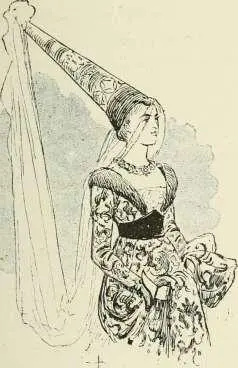
The great Heunin.
according to Brother Thomas, from the culpable extravagance of the hennin, and the Satanic escoffion. In the ardour of his con-viction the good friar did not stop at words; he seized a staff at the end of his sermon, burning with pious zeal, and pushing through the frightened crowd of women of all classes who had come to hear him, he effected a pitiless massacre of hennins, in spite of loud cries and vigorous hustlinsf.
" Down with the hennin ! Down with the hennin ! " now became the cry of the idlers and vagabonds, stirred up by Brother Thomas, as they hunted any woman whose head-dress exceeded the modest proportions of an ordinary coif through the streets.
For all that, sermons and molestation notwithstanding, the hennins were none the worse, but rose up as tall as ever after the monk had gone on his way. From town to town the latter continued his crusade, until at length he reached Rome, and there the unedifying spectacle presented by the capital of Christendom at that time excited him to such a jntch that he passed all bounds, and letting the hennins alone, he attacked the
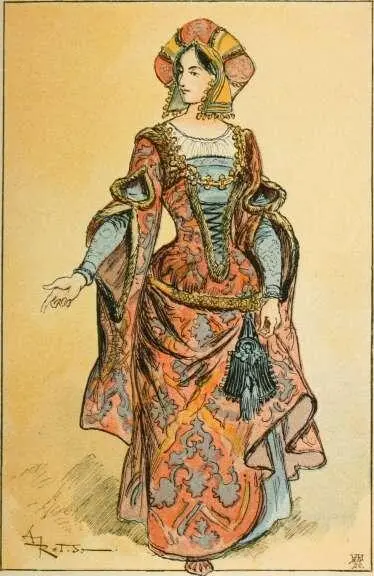
DAME SOUS ClIARI.nS VIII.
princes of the Church. This was a more dangerous game, and the poor man, being accused of heresy, was arrested and burned in public.
The history of Fashion lias the romance of fashion in it also ! What curious episodes there are ia the annals of feminine coquetry, and what romantic figures appear in them, some figures full of witchery and charm, some strangely poetical, but also occasionally dangerous syrens, witnesses against his age on belialf of poor Brother Thomas Connecte.
The history of Fashion might be written with a dozen portraits of women spread over the centuries ; portraits of queens of the right hand and queens of the left hand—more frequently the latter—great ladies and great courtesans. We need only name them; with each name we turn a page, or begin a new chapter : Agnes Sorel, Diane de Poitiers, Queen Margot, and Gabrielle d'Estrees, the first wife and the last ' mie ' of Henri Quatre, Marion Delorme, 'la grande Mademoiselle,'
Montespan, in the first period of the Sun-King's reign, Maintenon in the second period, that of the soured and world-worn monarch,
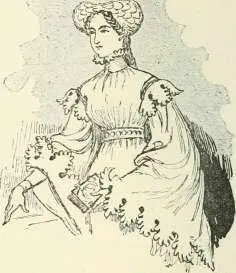
Cut out and pinked sleeves.
Madame de Pompadour, the triumph of the dainty eighteenth century, Marie Antoinette, the last sad ray of splendour of a world that had come to its end, Madame Tallien, Josephine Beauharnais, &c.
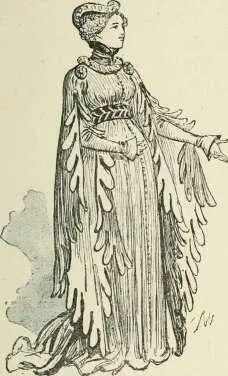
The Houppelaude.
After Isabeaii of Bavaria, Queen of France and of the Mode, the handsome and magnificent wife of Charles VI., she who was at first the queen of balls and festivals, but soon became the queen of the civil wars, without, however, abandoning her sumptuous costumes and fastidiously elegant surroundings —after the time and fashions of Isabeau, come the time and the fashions of Agnes Sorel, the ' Dame de Beauté ' of Charles VII.
Charles is idling at Bourges, no longer even thinking of reconquering his kingdom ; his mistresses and his pleasures make up his world. The great and saintly Joan has put on male armour and gone forth to fight the English ; she has already reconquered a large portion of his realm for the king; another woman who is neither great nor saintly is about to carry on her work. This is Agnes Soreau de Sainte Géraud, the beautiful Agnes Sorel, a blonde with blue eyes. By the power and ascendancy of her beauty she impels the King, her august servant, to attack the English, she makes him recapture the remainder of the realm of the fleur-de-lys, to^Yn after town, and earn from history the name of Charles the Victorious.
Читать дальшеИнтервал:
Закладка:
Похожие книги на «Yester-year; ten centuries of toilette from the French of A. Robida»
Представляем Вашему вниманию похожие книги на «Yester-year; ten centuries of toilette from the French of A. Robida» списком для выбора. Мы отобрали схожую по названию и смыслу литературу в надежде предоставить читателям больше вариантов отыскать новые, интересные, ещё непрочитанные произведения.
Обсуждение, отзывы о книге «Yester-year; ten centuries of toilette from the French of A. Robida» и просто собственные мнения читателей. Оставьте ваши комментарии, напишите, что Вы думаете о произведении, его смысле или главных героях. Укажите что конкретно понравилось, а что нет, и почему Вы так считаете.

